






Honoring



Basic Powertrain Coverage from Bronze up to Our Exclusionary Comprehensive Titanium Warranty.

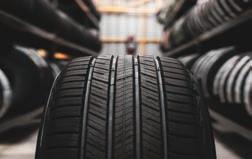
Road Hazard Comprehensive Warranty Including Battery Coverage.
Road Assistance.
Key Replacement. Tire & Rim.






RV Motorized & Non-Motorized
Covering Land and Marine Powersports. Travel Trailers. A,B & C Motorhomes. Park-Models.
GAP Protection Plan
O ers Coverage for your Vehicle in the Events of a Total Loss Following a The t, Accident or Fire.



USED CAR DEALERS
ASSOCIATION OF ONTARIO
230 Norseman Street, Toronto, ON M8Z 2R4
Tel: 416.231.2600
Toll Free: 1.800.268.2598 web@ucda.org ucda.org
Publication Mail Agreement #41890516
ONTARIO DEALER
is published by Laservision Graphics Ltd. four times a year.
130 Industry Street, Unit 36, North York, ON M6M 5G3
EDITOR
Gina Monaco
Tel: 1.647.344.9300 or 1.289.456.4617 gina@ontariodealer.com
ADVERTISING SALES
Office: 647.344.9300
Advertising Inquiries
Shannon Coleman slk.coleman@yahoo.ca 647.269.4191
DESIGN thrillhousestudios.com
CONTRIBUTORS
Chris Chase, Ronda Payne, Bill Sherk, Angela West, Lori Straus, Phoebe Wolfe
If you are interested in having your personal opinion heard, contact the editor at gina@ontariodealer.com

Lori Straus




Value up to $2,000
To Qualify:
•$10,000 minimum net purchases in Q3
•Growth in 2024 Q3 compared to 2023 Q3
Qualifying Period: July 1 to September 30, 2024

WIN 1 OF 6 TICKETS TO THE CN TOWER SKYWALK FOLLOWED BY DINNER AT THE 360 RESTAURANT
The event will be held in April 2025.
To Qualify:
•$40,000 minimum net purchases in 2024
•Growth in 2024 compared to 2023
Qualifying Period: January 1 to December 31, 2024
A PARTNERSHIP DESIGNED FOR GROWTH! ACCESS THE LARGEST INVENTORY IN THE INDUSTRY.
•Over 160 NAPA stores for easy service and delivery
•More than 500,000 domestic or import parts, supplies, and chemicals
•Over 300 historic partner suppliers
•Priority access to all parts for any year, make or model
•Industry-leading parts and labour warranty
•A custom price profile and loyalty rebate programs
•Consolidate your multi-dealership network for an annual rebate
•Lower reconditioning costs thanks to competitive pricing
•Industry-leading parts and labour warranty
DO YOU WANT THE CHANCE TO BE A WINNER?
To enroll in this program, you just have to be an active
and open an account at your local NAPA store. No activation fee. It’s quick and easy!

By James Hamilton, Executive Director, UCDA
IT’S HARDLY REVOLUTIONARY TO SAY TO ANY CONSUMER-FACING BUSINESS that customer service is important. That’s not going to come as a surprise to any business. Good customer service is usually the hallmark of any truly successful retail operation, but my sense is good service has become both harder to find and even more important these days than ever before.
When I say harder to find, I speak of my own experience dealing with companies in charge of our phones, cable, health, entertainment, travel, insurance and on and on. Ever try to quickly resolve a question, waiting on the phone for an hour or more, while the recording periodically reminds you how important your call is? They are right, your call is important, but they lose the thread on the execution.
Motor vehicle dealers have always understood the need to be responsive, you
don’t want to lose a sale because you did not return a call or an email, and proactive, because a small complaint can become larger if it is seen to be ignored.
While good customer service is as important as it ever was, and while it is becoming less and less easy to find, the consequences of not delivering on that promise is more serious than ever. Witness the thrashing airlines took over the 2022/23 holiday season, on review sites, Twitter, Facebook and countless other social media touchpoints.
Even more important to our industry is the simple fact that surveys show consumer brand loyalty pales in comparison to the decisions consumers make based on good customer service. The customer will buy the vehicle because they have been treated with the correct professionalism, care and attention, and less because it’s the same kind of vehicle they bought last time.
What that means is good customer service will bring you more business. This carries through, of course, to the after-sale experience. If, as with any used product, there are problems with a vehicle after the sale, and the dealer is responsive, open and helpful, the customer will remember that, and tell their friends and family about it. If you are lucky they will tell the whole world on social media! But if you drop that ball, they will almost certainly do all the same things in a negative way instead (my impression is they are in fact more likely to do that).
Think about all the points along the way where your dealership has the chance to establish, in the mind of the customer, good service:
I. Your online approach, website, advertising
II. The Customer Experience in the dealership
III. Interaction with salespeople
IV. Feature description, test drive
V. Negotiation and purchase
VI. Vehicle delivery
VII. Service and the after-sale relationship
Each stage along the way presents challenges, but also the opportunity to create a comeback customer. Dealers need to remember, for most people, buying a car, whether new or used, is a stressful and timeconsuming process. Dealers can bring very important value-adds to that fact, by making the process smooth, friendly, informative and pleasant for the consumer.
Who knows, if your efforts hit the mark, you may have a customer for life!
In addition to our regular articles, such as The Law Matters, Tech Talk, The Common Lawyer and The Old Car Detective, please enjoy the following articles in this issue of The Ontario Dealer:
• Better Relationships Move More Cars
• Understanding Buyers' Habits
• Embracing Personalization
• Balancing Automation with Human Contact
You can reach me anytime at j.hamilton@ ucda.org with any comments or suggestions for the magazine! ■




By Hetash Singh, UCDA Associate Legal Counsel
DID YOU KNOW AN $80,000 CONTRACTUAL OBLIGATION can be sealed by an emoji?

It can.
In this fascinating case out of Swift Current, Saskatchewan, a cute little emoji proved to be not so cute to a farming operation.
These were the facts in South West Terminal Ltd. v. Achter Land & Cattle Ltd.:
1. South West Terminal Ltd. (“SWT”) is a grain and crop inputs company.
2. Achter Land & Cattle Ltd. (“Achter”) is a farming corporation owned and operated by Chris Achter. Chris Achter is a proper representative of Achter. Chris Achter’s father is Bob Achter.
3. Kent Mickleborough is a Farm Marketing Representative with SWT, primarily acting as a grain buyer for SWT.
4. SWT has purchased grain from Achter through various deferred grain contracts since approximately 2012.
5. On March 26, 2021 at 1:01PM, Mr. Mickleborough texted the following text message to producers including Bob Achter and Chris Achter:
All Divisions - - Kent Mickleborough – Flax Prices : Flax 1Can(max 6% dockage) $22.50/bu Apr. $17.00 Oct/ Nov/Dec del
6. Following Mr. Mickleborough sending this text message, he received a call from Bob Achter. After speaking with Bob Achter, Mr. Mickleborough called Chris Achter. Following the phone call with Chris Achter, Mr. Mickleborough had a contract drafted for Achter to sell SWT 86 metric tonnes of flax to SWT at a price of $17.00 per bushel (which amounts to $669.26 per tonne) with a delivery period
listed as “Nov”. Mr. Mickleborough applied his ink signature to the contract, then took a photo of the contract using his cell phone. Mr. Mickleborough then texted the photo of the contract to Chris Achter at 306-264-7664, along with the text message: “Please confirm flax contract”.
Chris Achter texted back from 306-2647664 a “thumbs-up” emoji.
7.Achter did not deliver 87 metric tonnes of flax to SWT in November 2021.
8. The spot price that flax was trading at on November 30, 2021 was $41.00 per bushel (which amounts to $1,614.09 per tonne).
The fact the price of flax rose dramatically from $17 per bushel in March of 2021 to $41 per bushel by November of that year, might explain why the Achters were less motivated to honour the agreement and why SWT were so keen to pursue the matter.
In fact, Chris Achter argued there was no contract because the thumbs up emoji was not meant to convey acceptance of the terms, but rather just to confirm that he received the contract. The judge found that testimony to be “self-serving”.
In considering this the judge looked to past dealings between the parties, on other contracts, and noted that Mr. Achter often used short,
simple responses to convey acceptance. For example, in contracting for the provision of durham, again by text, he sent “looks good”, “ok” or “yup”.
The court went on to say:
“I am satisfied on the balance of probabilities that Chris okayed or approved the contract just like he had done before except this time he used a emoji. In my opinion, when considering all of the circumstances that meant approval of the flax contract and not simply that he had received the contract and was going to think about it.
In my view a reasonable bystander knowing all of the background would come to the objective understanding that the parties had reached consensus ad item – a meeting of the minds – just like they had done on numerous other occasions.
[37] Additionally, I find under these circumstances a emoji is “an action in electronic form” that can be used to allow to express acceptance as contemplated under The Electronic Information and Documents Act, 2000, SS 2000, c E-7.22 [EIDA] as per s. 18:
18(1) Unless the parties agree otherwise, an offer or the acceptance of an offer, or any other matter that is material to the formation or operation of a contract, may be expressed:
(a) by means of information or a document in an electronic form; or
(b) by an action in an electronic form, including touching or clicking on an appropriately designated icon or place on a computer screen or otherwise communicating electronically in a manner that is intended to express the offer, acceptance or other matter.
(2) A contract shall not be denied legal effect or enforceability solely by reason that information or a document in an electronic form was used in its formation”
In the end, the Saskatchewan judge ruled that a thumbs-up emoji can represent a binding contractual agreement and ordered the farmers to pay $82,200.21 (plus interest and court costs) in damages to SWT for the unfulfilled contract.
The judge clearly felt that the law needs to adapt to the “new reality” of how people contract, standing in a farm field with an iPhone texting terms back and forth.
You can read the full case here: https://shorturl.at/6Va3w ■
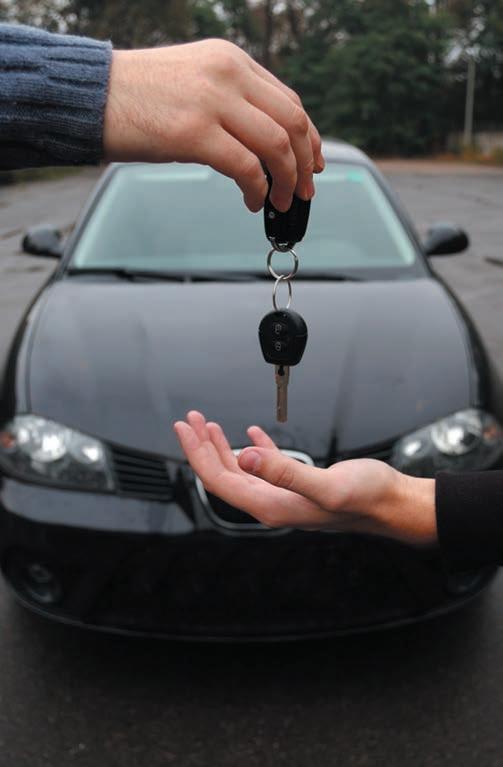
By Angela West
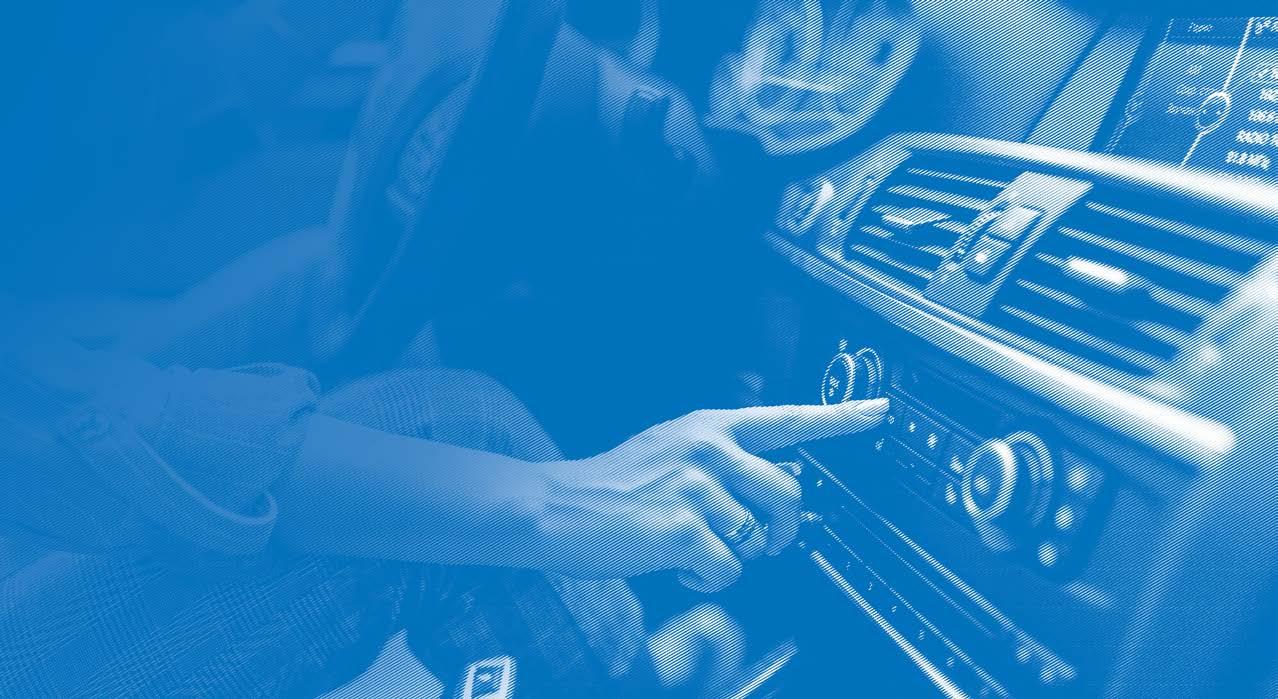
WHILE ALL THE HYPE MAY BE ON MICRO-TARGETED SOCIAL MEDIA ADVERTISING, there’s an old faithful marketing channel in the background: radio. While social media isn’t shutting down anytime soon, people are disengaging from Facebook, Instagram, X, and other channels. Radio doesn’t come with the societal and mental health issues of social media, and is far more engaging than print.
Rates have gotten more reasonable since advertisers have been going all-in online, making radio ROI more attractive. Despite the many other options available, commuters listen to it on their way to and from work, and people who work on the road may listen to it all day.
As of 2021, Toronto boasted the highest average number of radio listeners in Canada, with 5.87 million people listening daily - and that was with a much higher percentage of people working from home during that time. This number can only have gone up with a mass return to hybrid or inoffice work.
Don’t make the mistake of thinking that only older people are radio listeners. While Canadians over 55 listen to it the most with 18.8 weekly hours, 25-54 year olds run a close second with 16.5 hours. Surprisingly, 18-25 year olds spend 10.8 hours listening to the radio weekly.
Choosing the channel that works for your target audience
To kickstart your radio strategy, you’ll want to look at both local radio stations and SiriusXM. Ask customers who come into your dealership which stations they like, and you’ll soon have a clear picture of where you should be advertising.
You could also send a short email survey to your customer list to get an idea of their listening habits. Doing this work in advance will show you what your target audience listens to and narrow down your choices in larger radio markets like the GTA.
Podcasts are worth looking into to catch non-radio listeners
While it isn’t traditional radio, don’t sleep on podcasts. People who aren’t listening to the radio are choosing podcasts instead. Their listening is less casual than radio when they’re engaged with their favourite topics, which gives you more of a chance of getting their attention over someone listening to the radio on a casual commute. They’re great for brand awareness; 89% of brands have seen a higher awareness with podcast advertising.
If you’re sending out a customer survey, ask them what their favourite podcasts are - you can choose to engage directly with the podcast itself if a number of your customers indicate a particular one.
Otherwise, you can choose to advertise on podcast networks such as Spotify, or you can work with agencies that will find the right podcasts and networks for you. Networks are able to limit the geographic area, but some may limit it to Ontario rather than your particular location. iHeartRadio, PodCastOne and Art19 are three networks that are recommended for finely geo-targeted
advertising. Similarly, larger podcasts and networks will usually have better geo-targeting so you’re not advertising too far outside of your service area.
Crafting the right radio ad: take the local station’s help
If you’re advertising in a major market, your best friends are the radio station’s or SiriusXM’s staff. They will help you put together a fantastic commercial that will convert your target demographic. They are uniquely positioned to know what works and what doesn’t in their particular market and on their station. They’ll advise you on tone, how to craft a powerful call to action (CTA), and what their listeners like to hear.
What they can’t help you with is what you need to highlight. Hopefully, you already know what your unique selling propositions (USPs) are. You’ll want to focus on the ones that resonate with a particular station’s audience. If, for example, the station’s target demographic is middle-class men from 35-60, you will want to choose the appropriate USPs for that audience.
You generally only have room for one or two USPs in a short radio ad. Don’t try to stuff too many messages into one ad, this will confuse the audience. Ideally, keep it to one USP, one promotion, one “extra” message such

as an additional USP or call to like a social media channel, and a strong call to action at the end.
If you’re also working with podcast networks, you’ll generally need to write or even produce your own commercial. You will want to contract this out to an agency that specializes in audio commercials; your local station will be able to recommend someone.
For best results, radio ads should be running all the time to drive brand awareness. If your budget is limited, choose only one station and run constant advertising on it rather than having scattershot campaigns on multiple stations and channels. Remember, radio is a digital billboard; you have to run regular ads to really grab your listeners.
Radio advertisements can help to boost your social media traffic, particularly if you use it as a campaign component in multi-channel promotions. For example, if you’re running a contest on Facebook, mention it in your radio ads to drive listeners to enter. You do want to keep it to a quick mention; radio ads are short and you want the ultimate CTA to be your promotion.
In terms of showing ROI, hopefully you’re asking your buyers where they heard about you and giving them multiple items to check off, with radio and station being one of the selections.
Additionally, the radio station or podcast network will be able to give you the data which will help you calculate your ROI. While the data isn’t as good as the statistics you get from a social media marketing campaign since they can’t exactly click on anything, it will still give you a good enough idea of number of listeners, times of day, and other vital information.
One channel alone will not bring in buyers for large ticket items like vehicles; you have to bombard your leads with messaging from multiple mediums. Radio is a vital part of an omnichannel marketing strategy for dealerships, and one that won’t be going away soon. ■
By Ronda Payne
USED CAR DEALERS ARE UNLIKELY TO GO INTO THE BUSINESS because they are great at understanding the nuances of lending. Their skills lie in buying quality vehicles, understanding customer needs and matching customers to inventory.
But, just as dealers don’t often have a background in lending, few customers have the cash in hand needed to purchase their next vehicle; making lending a necessity. Ensuring an easy purchasing process is important for the dealer/ customer relationship yet learning the ins and outs of the lending process isn’t as easy as one might think.
Establishing relationships is a key part of all aspects of the used car sales process. This holds true whether it’s customers buying cars or lenders willing to fund the money for those vehicles. Strong, honest
relationships with mutual respect will go a long way to ensuring customers are satisfied on all sides of the process.
Match the lender to the customer
As Stéphane Pelletier, Senior Manager of Consumer Financing with National Bank of Canada says, there are a number of lenders available to match up with the various customer profiles.
“A dealership will have to work with a few lenders to make sure he is able to meet the needs of a few clients,” he says. “It’s a question of knowing the kind of business the lender is buying.”
Knowing the types of deals the lender has an appetite for will save everyone time and frustration.
“That’s the name of the game for the dealer,” says Pelletier. “He wants a yes and fast. How he can make that easier is by sending the deal to the right lender.”
Not only will aligning the deal to the right lender be more efficient, it will also save time and perhaps save the deal. As Pelletier says, a declined deal can give the customer time to think about whether they would be just as happy with the car they saw on another lot.
His colleague Manpreet Mangat, National Bank Senior Manager of Merchant Relationships, Ontario agrees, stating that getting to know the lender at the start of the relationship is key.
“At the start of the partnership, take the time to understand the lender’s risk appetite and programs offered,” she says. “Next step is then to filter the clients who are best suited for the lender and continue to follow policy, procedure and due diligence guidelines. Keeping a regular touch point with the lender rep is important to get updates.”
She adds that knowing the customer is essential and this facilitates sending accurate information to potential lenders. Filling out a complete Know Your Client (KYC) before sending in applications should be part of the process as should an appreciation of the customer’s credit rating. Additionally, knowing the customer’s residency status is part of the package as there are different programs for newcomers to Canada.
Lenders monitor deals, so there must be an ongoing flow of accurate information and transparent communication with dealers. Having the KYC and a prequalification done up front will go a long way to showing a lender the right steps
are in place to gather correct information. A handful of great partners
While it may seem tempting to send a customer’s application to every possible lender in the hopes one of them will pick it up quickly, this type of tactic can do far more harm than good according to Pelletier.
“At one point, if the dealer is sending to a lender the kind of profile he’s not looking for, it’s a waste of time for everyone,” he says. “It’s not a question of good faith or not. It’s a questions of risk profile that the bank is not ready to consider. If at one point, out of 400 deals a dealer sends to a bank, 95 per cent of them are declined, the lender will say, ‘I’m wasting my time with you,’ and they might decide to close the agreement.”
However, Mangat notes that sending an application to more than one lender in order to create a safety net is a good idea, provided all the lenders are a fit for the client profile.
“Most dealers send a file to multiple lenders to have a backup plan,” she says. Therefore, sending the right kinds of deals to lenders is part of the relationshipbuilding process. Pelletier also says it only takes a few lenders to have the right options available to meet customer needs. While National Bank isn’t interested in someone who had a bankruptcy in the last couple of years, there are lenders that are open to those types of customers.
“You don’t need 10 different lenders. Maybe three or four good lenders and you’re able to meet all the needs of all your clients,” he says. “By limiting the group of lenders you’re dealing with, it’s easier for the dealer to better understand the lender’s policies and processes. The dealer needs to adapt a bit.”
The process involves much more than just the customer application says Mangat. “The dealer needs to ensure they take the time with the clients to educate about the financing and at the same time, choose the best program that fits client

needs in terms of term, amortization and payment,” she says. “Having deep knowledge of the credit products, client’s risk rating and their cashflow is essential in the process.”
Having more than a handful of lenders at a dealership can also cause lenders to end the relationship because they aren’t getting their piece of the pie. Therefore, a good lender relationship ensures the right kinds of business as well as a steady stream.
The relationship goes both ways and as Canada’s sixth largest bank, Mangat says dealers can feel reassured major lenders like National Bank can support clients through a dedicated team with its consumer financing sector. Before creating a lending agreement with a dealer, the lender should know the dealer’s type of clientele to avoid any misunderstandings.
While some dealers have capacity for and interest in finance specialization, other dealers recognize the amount of information and financial knowledge needed to do a great job. And that’s even before getting to know each lender and their lending preferences. It isn’t for everyone.
This is where financial service brokers like Orit Koren, CEO of Trillium FSB, (trilliumfsb.com) come in. Having been in business for 25 years and the only automotive lending services broker recommended by Ontario’s UCDA, Orit helps dealers focus on what they do best while she takes care of the lending.
“I provide financing solutions to dealers who don’t have their own solution,” she says. “Lending is a whole separate set of skills from buying and selling cars.”
Working with someone like Orit ensures the necessary lending knowledge is already on deck and the process can be both efficient and effective.
“I have a very good relationship with my lenders and work with a lot of dealers,” she explains. “You get access to knowledge and experience of 25 years that can get your deals done without having to worry about the process. The process is very streamlined because it is remote and digital.”
Orit works with about 10 different lenders, National Bank is one of them, and she knows what each is looking for in their deals. Approvals can happen as quickly as same day.
She is particular about the kinds of dealers she chooses to work with. Because she runs her business very cleanly and transparently, she is interested in dealers who are the same.
“I want someone who puts the customer first,” Orit says. “With integrity and wants to sell good products. Our goal is to help them sell more cars.”
The choice of funding method is up to the dealer. Those that have capacity and interest will want to form relationships with lenders directly. Smaller, newer dealerships as well as those who aren’t interested in taking on the process of understanding the distinct nuances of each lender will benefit from working with an auto lending broker like Orit. ■
AS AN AUTOMOTIVE DEALER, YOU LIKELY KNOW WHAT DOES AND DOESN’T WORK when connecting with your customers. Like the old saying goes, “If it ain’t broke, don’t fix it!” But the market has changed drastically in the past few years, and new legislation has affected how you can sell.
Let’s look at how the car buying process has shifted and evolved in recent years, how you can understand and motivate buyers today, and what upcoming trends to expect for the future.
The most significant recent event in the automotive industry was the global semiconductor chip shortage, which began in 2020. Various natural disasters and efforts to fight the spread of the novel virus contributed to a severe lack of semiconductor chip production.
This greatly impacted the production of consumer electronics and the automotive industry, derailing operations and supply, preventing sales, and cutting workforce numbers.
To put it mildly, it was not a fun time. Fewer vehicles were produced, and the industry saw a steep decline in automotive sales. According to a 2023 report by TD Economics, 2022 was the worst year for car sales since the beginning of the pandemic.
Without enough new cars available, the demand for used cars soared, resulting in a 34.5% price increase in 2021, which
was noted in an article by The Gazette from 2023. Average used car prices have since decreased, but they remain higher than historic levels. By comparison, the Kelley Blue Book confirmed that new car prices are currently at their lowest point since 2022.
Those drops and increases happened so fast and were so extreme they caused whiplash in anyone who had to pay attention to them.
Cox Automotive, the parent company to Manheim Auctions, Kelley Blue Book, and more, now predict that 2024 may be the first year that resembles “normalcy” since pre-COVID19. Growth will likely be slow, but supply and pricing are expected to return to regular numbers again, giving consumers a wider range of choice than they’ve had in years.
But even if the market evens out, dealers can’t expect buyers’ habits to be unchanged, including what medium buyers prefer to use when car shopping.
A consumer study done by Cox Automotive in 2022 revealed that 80% of those surveyed said they would prefer to purchase a car completely online. Autotrader released a study, conducted by DIG Insights, this year, reporting that 80% of shoppers use online sources when purchasing a car.
Consumers now have access to a growing number of online showrooms, offering them a completely virtual retail
By Lori Straus
experience with the option to book an inperson test drive or other appointment on their own time.
Browsing for a car online offers consumers many benefits:
• Convenience: easily sift through vehicles from the comfort of home, saving time and money getting to physical dealerships.
• Wider selection: access a much wider range of vehicles at once.
• Easier comparison: quickly compare multiple vehicle stats and reviews simultaneously.
• Clear pricing: prices listed online or made available upon virtual request, calming the fear of being upsold.
Purchasing online also means consumers can avoid feeling pressured by sales staff in person. As a dealer, you want potential customers to feel comfortable in your showroom. Recognizing the added pressure an in-person sale can bring is important when trying to understand where your buyers are coming from.
Not only do online sales benefit customers, but they can save your dealership a great deal of time and money too.
In 2022, the Ontario government launched the Digital Dealership Registration (DDR) initiative. This program allows dealers to register vehicles online, which means you can get permits and licence plates issued
directly to your place of business. This reduces paperwork and limits delays. At first, DDR only applied to new vehicles, but as of July 2023, used cars can be registered online, too. Today, more than 7,000 passenger vehicle dealerships in Ontario can register for DDR.
The shift to online sales means you may need to review rules and regulations. To put it simply: If your dealership sells online, you’ll still have to follow all the same rules of disclosure as brick-andmortar businesses.
As with in-person sales, all dealerships and companies that wish to sell vehicles online in Ontario (and access DDR) must be registered with OMVIC. Online sales must also still include a physical business address of where the agreement was entered into within their contracts.
Just like in-person contracts, the MVDA doesn’t require dealerships to offer a cooling-off period for online sales, but many dealers do provide one for sales completed without a test drive.
To ensure your full compliance with the law when selling vehicles online, review updates to the MVDA and other related
crucial to the success of your dealership. Although many consumers want to move to an online sales process, your expertise shows that the showroom experience can make or break a sale.
But even an online sale requires human contact when a car is dropped off at a customer’s home, either for a test drive or after the purchase.
OMVIC also require online dealers to keep a place of business open where a customer can come by in person to ask questions. Such an online dealer may not be required to have vehicles on the premises, but a staff member must be there.
Ontario law stipulates that all offpremises trading is illegal. For dealers operating predominantly out of a dealership, this isn’t news, and you probably have processes in place to ensure compliance. For online dealerships, though, OMVIC may impose certain terms and conditions to ensure you’re in compliance.
Now to the important point: How do all these changes affect how you understand customers? After all, who enjoys waiting
the options available. But as production starts to reach regularity again, buyers may revaluate their needs. They may also believe the industry is recuperating faster than it actually is. Expect to take time to (still) explain the state of the industry and why it hasn’t fully recuperated yet.
With proper research and the right approach, you can improve your knowledge of current buyer habits and motivate new customers to close a sale at your dealership.
This may sound obvious, but it’s all too easy to spread your net too wide and end up catching nothing.
Before you dive too deep into marketing, define who you’re trying to reach. If you haven’t done this exercise in a while, now is a good time to give your marketing strategy a refresh.
Develop a profile for your dealership and compile answers to questions like these:
• What demographic typically comes into your dealership?

• How has this changed in the past five years?
It goes without saying that who you target should also be based on the type of cars you’re selling and your sales territory.
What can be harder to define are changes in who you’ve been selling to these past five years. Use whatever sales data you have to update your ideal customer profile.
Consumers today are generally welleducated on the car buying process. They’ll know the basic steps and will likely have a list of non-negotiable needs and flexible wants for their next vehicle.
For many drivers, the most important criteria in picking a new car include:
• affordable price
• excellent fuel efficiency
• high safety rating
• good warranty
• overall design
Finding out what kind of features are currently trending in popularity can help in your marketing efforts. For instance, backup cameras are becoming increasingly desirable.
Thankfully, they’ve been federally mandated for all new cars since 2018, increasing your chances considerably that your used car stock will have vehicles with one already installed.
But also ask your salesforce to fill out quick questionnaires on customers after they’ve left the office. We know: paperwork and sales teams go together like engine oil and water. But they’re actively engaged with your customer base. Make the questionnaire super short: consistently reported basic data is better than inconsistently reported, detailed data.
You can also send out a survey to your customer email database. Offer a token of appreciation for completion, e.g., a free oil change.
Previously, dealership marketing often revolved around encouraging buyers to visit the showroom. Today, however, with the shift to online sales, understanding your buyers from a distance should be a top priority.
Find out what social media platforms your target market is on. Is it more lucrative for you to focus on Instagram, Facebook, or email? Hiring a marketing consultant or social media coordinator can help you establish a presence on the platforms your ideal buyer is likely to be on, expanding your reach within this pre-determined target.
Giving buyers confidence in your expertise can help you gain their trust. In both your marketing and in-person interactions with buyers, you and your team should focus on sharing your knowledge about the car buying process and provide examples of how you can solve roadblocks and ease doubts. The goal here is to present your team as automotive experts without bulldozing over the customers’ wants.
To wrap things up, put out an enticing offer that encourages a decision with a sense of urgency (i.e., a limited time offer). But timing here is key: If a customer feels like you’re rushing them into a sale without enough information, they’ll likely leave with a sour taste in their mouth.
Several trends are on the horizon for the automotive industry. Keeping yourself informed of these predictions will help you align your dealership and its approach to understanding buyer habits.
EVs have been steadily climbing in popularity. By 2025, Bloomberg New Energy Finance predicts that 10 percent of all new car sales will be EVs. By 2030, EVs
will account for 30 percent of all vehicles on the road. Furthermore, the Canadian government has set 2035 as the year new car dealers can sell only zero-emission light-duty vehicles. Begin researching who in your customer base would be interested in these kinds of vehicles. If you can’t think of anyone, consider adding a new customer profile to your efforts.
Through and past 2024, car buyers are expected to continuing moving toward the internet for all their automotive research and purchasing. As a dealer, you and your team will need to anticipate this increased interest for technology in the car buying process and potentially upgrade your current marketing tactics for bringing in sales.
According to the 2024 Global Automotive Consumer Study by Deloitte, younger drivers are increasingly interested in vehicle subscription services, where they rent a vehicle for a brief period instead of financing their own car full-time.
Maintaining a car is not a cheap, and with the difficulties of today's economy and overly competitive job market, younger people are cutting more luxuries out of their life, including cars. Unless the cost of living comes down, your dealership may need to eventually redefine their target market in response to this change.
Data collected in a report by Cox Automotive showed that the automotive industry appears to be shifting from a seller’s market to a buyer’s market, prioritizing consumers again. Moving forward, dealers need to remain adaptable to the changing market and trends of buyer habits. Staying flexible will help you understand the wants of your customer base and allow you to offer them vehicles and services that suit them. ■
By Angela West
Get geared up for summer with these gadgets, accessories and apps which will help you enjoy the journey as much as the destination.
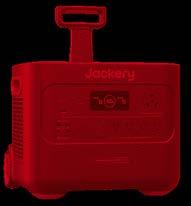
Gone are the days of just needing a couple of USB chargers in your vehicle. If you’re loading up the family for a road trip, your power needs have expanded to tablets, multiple phones, and other assorted gadgets. Jockeying for chargers is a common backseat fight that can be completely avoided with a portable power pack.
The cheapest one available from Jackery, one of the leading brands in this space, has an MSRP of $419.99, and it’s enough to fast-charge multiple phones and tablets for hours on the road. You can even plug a USB charger into your car charger to power it
so it’s barely drained by the time you reach your destination.
If your power needs are larger than what you need for a long car ride, more expensive models are available that can power much more, right on up to full appliances.
To find out more and see Canadian prices, visit ca.jackery.com
If you’re going to be rolling down some dusty roads, you’ll be hitting a few bumps. The WixGear magnetic phone holder fastens to your air vent and holds your phone steady in any condition with the power of magnetism. Say goodbye to distracting phone bounce and hello to smooth, easy map navigation with your smartphone. It comes with two mounts for two phones.
This product is available on Amazon for $19.99. To find it, search for “WixGear Magnetic Phone Car Mount” on amazon.ca
If your vehicle isn’t new enough to have CarPlay or a similar smart console system, you can get the Amazon Echo Auto on Amazon for under $100.00 to upclass your driving experience. You don’t have to be an existing Alexa user to get it, but it does pair with your home system if you are - so you can do things like turn lights on or off at your home with a voice command from your car. This is a game-changing upgrade for anyone with an older vehicle at a very reasonable price point.
Available on amazon.ca, search for “Echo Auto.”

If you don’t have a backup camera and don’t want to spend thousands of dollars on an aftermarket solution, you don’t have to. WOLFBOX has a number of solutions to choose from, including ones that attach to your rearview mirror. Installation does involve running a cable through your car and mounting it, but that’s all. Better yet, the lower end solutions will run you under $200.00.
Explore the full product range at ca.wolfbox.com
There’s nothing worse than packing up the car and finding out that your keys slipped into a bag or a box or down in-between the seats. The Tile key finder is OS-agnostic, meaning that you can use it on an Android or an Apple smartphone.
It’s cheaper than an Apple AirTag, and comes with a slot for your keys, unlike the AirTag. Since it is made by Life360, if you’re already on the app, the integration is easybut installation is simple without it.
Protip: 2-packs are cheaper than buying them one at a time.
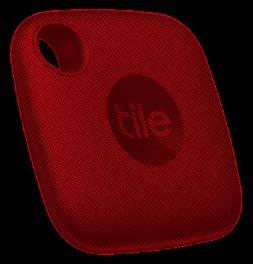
Stop looking for confirmation emails, booked times for activities, or anything else. TripIt analyzes your email inbox and finds all the stuff you’re doing and what you need. Confirmation numbers, dates, times, and everything you need is laid out in an itinerary for your trip.
This is doubly handy to ensure that you have the right dates and times for hotel reservations and activities - it’s easy to get these wrong if you’re booking multiple items at once, but TripIt will help you catch any errors and keep everything organized in one app.
Download it from your smartphone’s app store.
PackPoint Premium Packing List app
While it isn’t free, this app is indispensable to those who want to make sure they don’t forget anything. It forecasts weather on your proposed route and makes suggestions for clothing, allows you to set up a library of items you own to make repeat trips a breeze, and just generally acts as your packing concierge. If you’re a busy professional, tend to forget things, or just have a family where you need to keep track of far too many things, it’s worth the investment.
You can download a free version, but if you want to take advantage of things like a repeatable packing list and integration with TripIt, you’ll need to pay a very low cost for it.
Find out more at www.packpnt.com and download it from your smartphone’s app store.
This is the Cadillac of road-trip planning apps, and it will set you back to the tune of $40-60.00 USD per year depending on the level of membership you choose. You can plan trips with friends and family, get real-time wildfire smoke maps, find crown land, see where you can park your camper overnight, and much more than we have room for here. If you are traveling with a recreational vehicle or spend a good chunk of your summer on the road, it’s definitely worth getting.
Find out more at roadtrippers.com
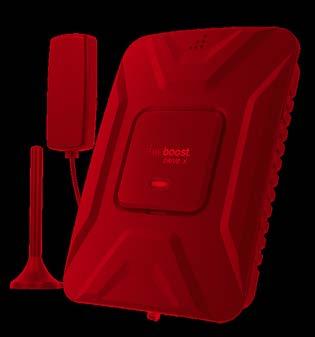
Cell Phone Booster
You may have one of these at the family cottage, but did you know you can have one in your car? Boost your signal so that you can make calls and use your data anywhere you happen to be with the WeBoost Drive X. While it’s a bit on the pricier side - just over $500.00 for the standard model - it’s well worth it if you have to work on the road regularly or are taking a longer road trip. Plus, if the destination you are traveling to is out of regular cell range, you can hop in your car to make a call if you need to.
Visit weboost.ca for a selection of major retailers and online shopping in Canada.
Charting Your Navigation Apps: Google Maps + Waze is the perfect combo
Road trips run on Google Maps, and pretty much have since it took the crown from MapQuest before zoomers were born. Apple fans will want to at least have Apple Maps turned on so they can easily find local landmarks and restaurants with Siri, but for anything more than short-term navigation Google is still the one to beat.
However, that’s for the longer legs of your journey. If you have to navigate in a highly urban area such as Toronto or Ottawa’s downtown during construction season, you need Waze. Waze has the added advantage of showing where construction is happening so you can avoid it, plus many other micro-items that Google Maps just doesn’t have. Using Waze can mean the difference between making it to something important on time or not.
Google Maps is better than Waze for highway driving and rural areas, but Waze is a must-have if you’re spending time in the city at any point over the summer.
Wherever your summer journeys lead you, we hope you have safe and happy road trips. ■
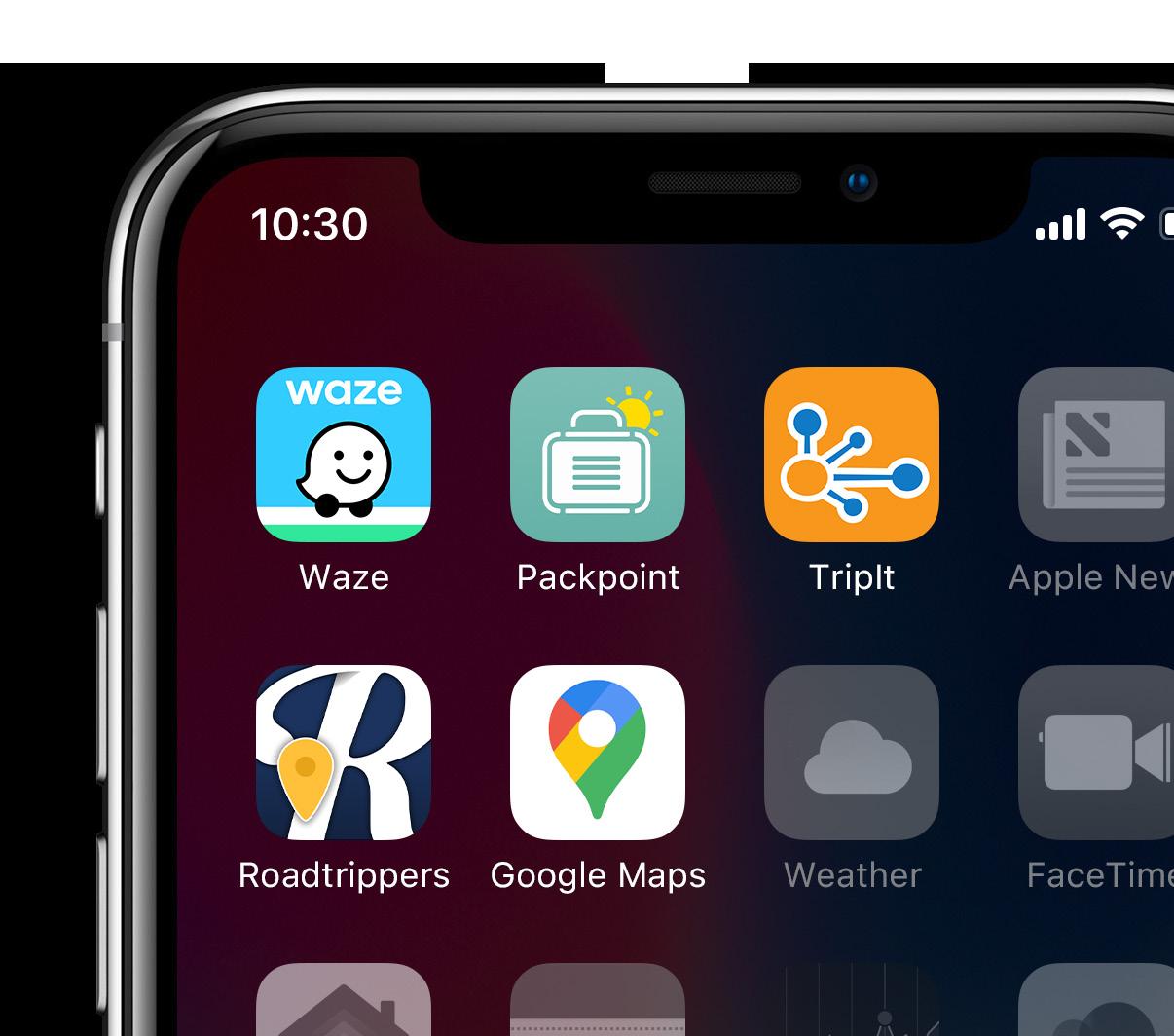
By Ronda Payne
countryautomotive.ca
AN UNCOMMON YET ENVIABLE UPBRINGING MADE CARS A KEY PART OF AMANDA COUTTS’ LIFE. Fortunately, her husband Ryan had the same focus on automobiles and together the pair started Country Automotive in Dundalk in 2013 after several years working within the industry.
“I grew up in the country and I find that in the country, you tend to be very hands-on,” Amanda says of her childhood. “Hanging out with my dad in the garage making repairs and changing tires was just something I did.”
She explains the love of cars was actually something her whole family got on board with. “My family didn’t have a dealership or anything of that nature, but we had a great love of vehicles,” she says. “Very specifically, older model Mopar cars and trucks.”
The family would often travel around to car shows and from that, Amanda gained knowledge about cars, engines and the people who love cars. It
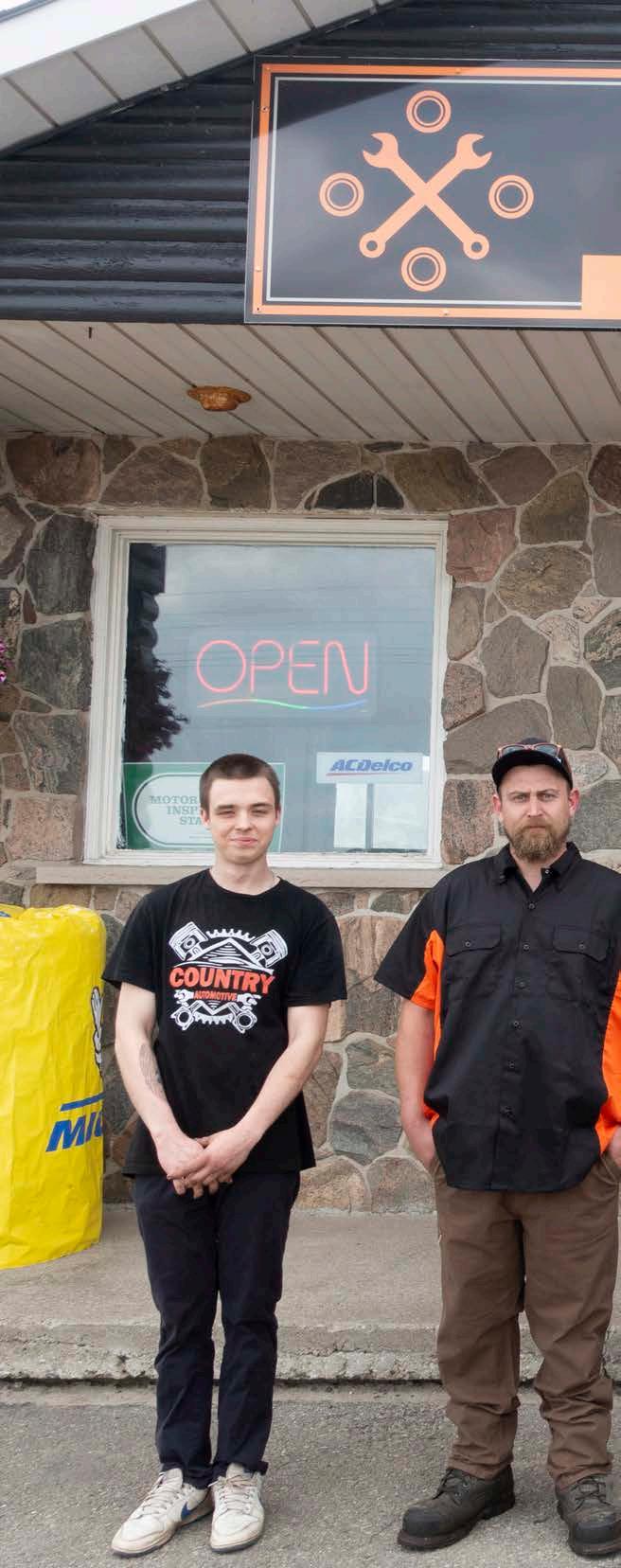
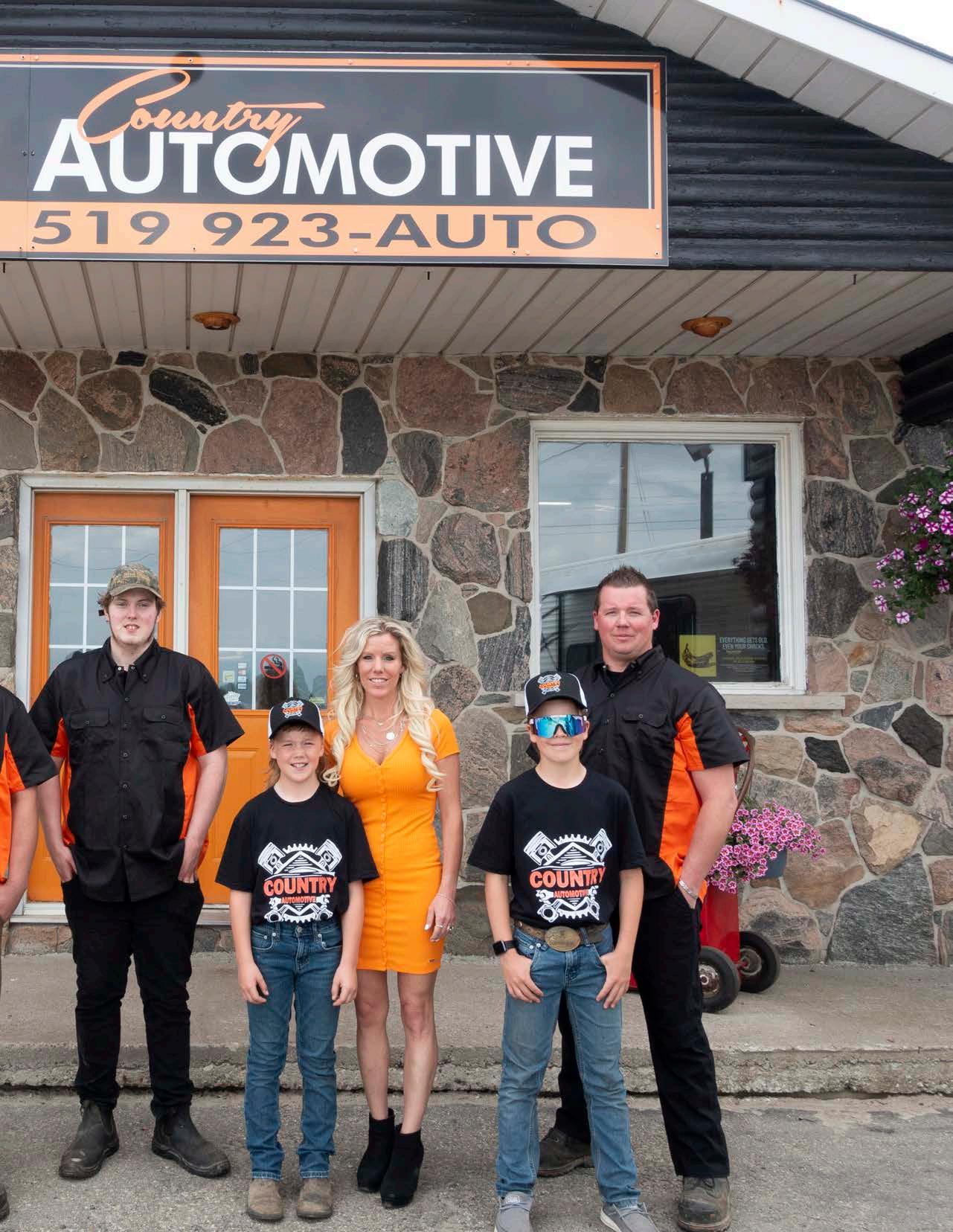
led her to be passionate about cars, like her mom and dad, which later translated into a love of the industry.
“I feel very privileged,” she says. “Some people would look at it as a negative to be sitting there, wrenching in the garage with my dad as a little girl. I loved fixing things. It was a huge sense of accomplishment.”
She started working in the industry in her late teens both in the front office and in the shop. She knew the value of working hard and wasn’t afraid to put in the effort to achieve her dreams.
In high school, Ryan was in the automotive program and served an apprenticeship as a co-op student at a local garage. He took a full-time position there and although he later worked at other dealerships, the automotive industry remained a constant for him.
After the couple married and started a family, they decided to test their entrepreneurial spirit. Their first son, Chase, was a toddler and their second son, Wyatt, was less than six months old when they moved forward with their dream of starting their own automotive business.
“Of course it was a huge undertaking,”
Amanda admits. “We started as just a repair shop.”
Then, just a year after starting out in the repair industry, Country Automotive expanded to include used auto sales. She credits individuals from UCDA with being teachers and mentors to her when she took her OMVIC MVDA elements course dealing with law and ethics.
“I recall being there, in the class and thinking, ‘I really hope I can pass this and I really want this,’ and it all came really naturally,” she says. “I started in what many would call a man’s world. I went to my first auction and everyone immediately looked at me. I was the only woman there.”
Fortunately, Amanda’s personality positioned her well to deal with that and other similar situations. Although a few of the men at her first auction asked her if her dad owned a dealership and she explained that she actually owned a dealership, everyone was kind and welcoming of her foray into the industry.
She refused to let something as insignificant as male or female dominance in an industry stand in the way of her success.
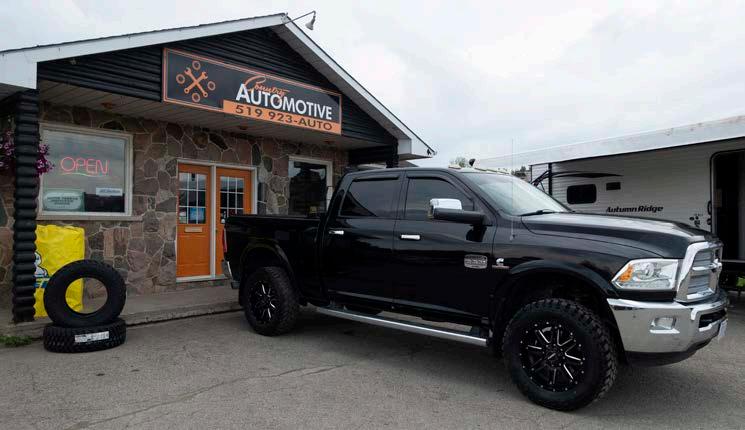
“I knew I could not let any barrier stand in my way. It’s just business to me. It doesn’t matter who’s there,” she says. “Male or female. It doesn’t matter. It’s a matter of the task and doing what needs to be done. It was about my passion for the industry.”
Since then, Amanda has run the auto sales side of Country Automotive without a thought of it being a “man’s world.” Ryan is the head mechanic of the two-bay shop and manages the workload he shares with two other technicians and an apprentice.
One of the technicians has been with the business almost since day one. Amanda remembers interviewing him and describing herself and Ryan as “keepers” and hoping he was interested in a longterm job as a tech. He said he was, and now, 10 years later, he’s still a major part of the business. Recently, Amanda asked him if back then, he could have imagined being with the company after all these years. He replied that there’s no place he’d rather be.
“We look at potential new employees or co-op students with the question of whether they are genuine humans with the mindset of strong family bonds,” she says. “Do they care about

the people in the world and how to treat them. We may be old school, but respect is huge for us. We always give respect and we hope to receive it.”
Family bonds are apparent to everyone who visits Country Automotive. It’s very much a family business with Chase and Wyatt already showing their preferences for being part of things.
“My one son is about the sales and the other one won’t put the tools down,” she explains. “They come in over the summer to earn some extra cash.”
At the tender ages of 12 and 10 it’s clear they take after their parents in terms of a willingness to work and a love of cars.
“Our children joke that they’ll take over our company one day and the fact of the matter is that they probably will.” Pre-COVID, Amanda stocked upwards of 15 cars at a time, but the changes to pricing, availability and demand caused her to rethink how she was going to do things going forward.
“We don’t stock as many right at the moment,” she says. “Over COVID, stocking that many seemed kind of silly because the prices would change.”
She’s selective about what she will buy for the lot. One-owner cars are her preference and they have to be clean. “I certainly wouldn’t sell it if I wouldn’t drive it myself,” she says.
But not stocking the same volume of cars doesn’t mean a reduction in sales or serving customers. Instead, it’s evolved into a more focused approach as customers come in asking for what they know they want.
“We’ve gotten to know them over the past 10 years,” she says of the operation’s loyal customers, who are treated like family. “I’ve been very keen to search for exactly what they’ve been looking for and I get them exactly what they want. I find it for them and they are more than satisfied. So, there’s not a bunch of inventory sitting around.”
Both Amanda and Ryan are deeply dedicated to their community. Sons Chase and Wyatt are in minor hockey, so that’s a natural fit for the business to lend support. But it goes significantly beyond that.
“I have the privilege of being the chair of the parent council here in Dundalk,” she says. I help make decisions and raise money for those schools.” And if that weren’t enough, at age 37, she pursued a dream she’d had when she was younger.
“I said to my children that when I was 20, I wanted to be a firefighter. I didn’t apply to do it because I was so busy,”
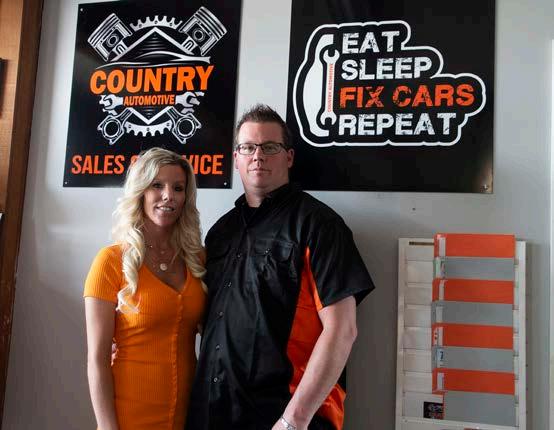
she explains. “I needed to try to see if I could do this. I needed to prove to myself whether I could or couldn’t.”
Turns out she could, and today she is a volunteer firefighter which keeps her involved in the community on a regular basis from a different angle.
It’s an interesting standpoint for her because, again, she is in a maledominated profession.
Her contributions have been recognized by her community, as recently, she was awarded the International Woman’s Recognition award for leadership and inspiration. “I tell my children they can do anything they want,” she says. “It’s no different than being a female walking into the automotive industry. If you want it, you work for it. If you can’t achieve it, you accept that it wasn’t meant to be.”
But taking the time to get to know customers and treating them the way they want to be treated absolutely was meant to be.
“We’re honest, we take the time to explain things,” she says. “Whether it’s a repair or a vehicle sale, I’ve spent hours in a vehicle showing people all the features. It’s not about the dollar, it’s about the way that we treat humans and the service we provide.” ■


By Justin Jakubiak and Bree Pierce
I SHOULD START BY ADMITTING THAT I DON'T LIKE CHANGE. I like consistency and knowing what lies down the road ahead.
That said, I will admit that change can sometimes be positive, especially if applied thoughtfully – and with respect to the automotive industry – if applied with the best interest of consumers as well as the industry as whole, including dealers and salespersons. Fairness across the board should be the name of the game.
This purpose of this article is to discuss some industry changes that are coming down the pipe, some of which will have a significant impact on dealers and salespersons. Notably, especially having regard to the current economic environment, some of the proposed changes will likely result in significant economic costs to dealers. In response
to these proposed changes, one must ask what is really driving them.
My fear is, that while cloaked under the auspices of consumer protection, many of the proposed changes are really designed to empower the Ontario Motor Vehicle Industry Council ("OMVIC"), simplify the industry, and make it harder to be a successful dealer or salesperson in Ontario. The changes may certainly address some of the bad behaviour of some dealers and salespersons – and that isn't inherently a bad thing - but at what cost? And who is left to bear that cost?
Should all dealerships and all salespersons be punished (i.e., deprived of certain economic benefits and opportunities) because of the bad behaviour of some? Or, should OMVIC be better and do better and focus on targeting and punishing the industry's bad actors?
I, for one, would like to see the bad actors punished and be made examples of; and the good actors given all the opportunities in the world to thrive, reach new economic milestones, and to grow in all aspects of their business. The proposed changes don't achieve these goals.
Revisions to the Motor Vehicle Dealers Act, 2002 (the "MVDA")
The Ministry of Public and Business Service Delivery is contemplating changes to the MVDA and its regulations, which has sparked significant debate within the industry. The proposed
changes mostly aim to enhance consumer protection measures and regulate the vehicle sales process more effectively. However, several dealers, dealer groups and trade organizations, such as the Used Car Dealers Association of Ontario (the "UCDA"), have expressed concerns about the potential negative ramifications of the proposed changes, to dealers and salespersons alike.
The following are a few examples of the proposed amendments:
• Requiring OMVIC to develop an information guide for consumers and for registrants to provide a copy to consumers.
• Allowing trade outside a dealer’s place of business when the consumer has initiated contact with the registrant and requested a trade outside of the place of business.
• Limiting the ability of dealers to require consumers to purchase add-on goods and services in a motor vehicle sale.
• Limiting the sale of “as-is” vehicles.
While the above are reflective of some of the industry's pain points, I remain unsure if amending the MVDA is the panacea some people believe it to be. I have long believed that more consistent and better enforcement by OMVIC would be much more effective in improving the industry and ensuring compliance with the MVDA and its regulations.
BUT – by improvement, I do not mean to suggest that the answer is to give OMVIC more powers or greater jurisdiction. I sincerely fear that if we were to do so, without improving OMVIC's knowledge and in-depth understanding of the industry, we are in for some very rocky roads ahead.
I work with OMVIC nearly daily on behalf of dealers and salespersons of all types – on behalf applicants, new registrants, as well as established industry kingpins with decades of experience and multiple stores throughout Canada and beyond.
While the vast majority of OMVIC's team members are truly excellent people that are great to deal with, there is currently a lack of industry depth (among some) when it comes to their understanding of dealerships and their operations, automotive financing, and in some cases, even what is provided for by the MVDA and the regulations thereunder. This problem has been compounded in recent years with the steady stream of OMVIC veterans who have departed for other regulators and taken their institutional knowledge and experience with them.
OMVIC cannot regulate effectively or efficiently without in-depth knowledge, experience and a full understanding of the industry, its people, and its practices. It is that simple. Knowing the MVDA and its regulations is not nearly enough.
I regularly see OMVIC focus on the wrong dealers and the wrong salespersons – choosing to grab some low hanging fruit rather than focus its efforts on the industry's real problem children and systemic issues. What can OMVIC do to improve? Here are 3 initial suggestions (I have many more, but only so many words):
• Hire from the industry – engaging a few experienced former salespersons and managers will be hugely beneficial in helping OMVIC lawyers, investigators and staff understand what is typical, what is common and what are the industry standards.
• Educate on the industry – regularly train OMVIC staff on the products and services offered by most dealers. OMVIC staff should intimately understand the various warranty and other products available for consumers to purchase, the different forms and types of leasing and financing available, how dealer management systems work (and often don't), and how the operations of a franchise dealer differ from a small mom and pop store, etc.
• Understand subprime and all its facets. Without understanding how subprime works on a granular level, and what typical deals look like (and how salespersons, dealers and banks make money from subprime financing), OMVIC will never be able to police it.
The above examples are but a few of many. I can't tell you how many times I have been working with an OMVIC representative and it is painfully clear that they don't know key aspects of the industry. If you don't know it, you can't explain it, nor can you provide any meaningful or effective enforcement or training.
While I am generally concerned about most of the proposed changes, none concern me more than the proposal to provide OMVIC's Discipline Tribunal (previously Committee) with greater powers.
Currently, the Discipline Tribunal may consider and determine whether a registrant has failed to comply with the Code of Ethics and may, by way of penalty, issue a fine or require a registrant to take educational courses.
The ministry is proposing to broaden the scope and powers of the Discipline Tribunal to give it authority to consider whether a registrant has failed to comply with any provision in the MVDA or its regulations, and to provide it with the power to
suspend, revoke or apply conditions to a registration – these powers currently rest with the Licence Appeal Tribunal (the "LAT") – an independent, quasi-judicial body that was specifically established to resolve disputes regarding licensing regimes and activities.
Why would anyone want to move decision making authority regarding one's ability to be registered, or continue to be registered, over to a nonindependent quasi-judicial body that is effectively controlled by OMVIC/is OMVIC? It is such a terrible suggestion that I am shocked that I must write about it.
A registrant's licence is extremely important – it is a method of earning an income and can be representative of a registrant's reputation and adherence to high standards. In the case of dealerships, a licence can impact the lives of many individuals (such as employees and their families, and in some cases, whole communities). It is therefore vitally important that a strong, fair, and efficient process is invoked before a licence is revoked.
Historically, it has been clear that the Discipline Tribunal's members don't have the skills or the legal training to provide effective and fair process before the Tribunal. Procedural fairness, natural justice and integrity are all cornerstones of our legal regime. The Discipline Tribunal, as it is currently constituted, sides in favour of OMVIC more than 99% of the time. That is hugely concerning and does not instill confidence that the Discipline Tribunal can take on more responsibility (and changing its name doesn't move the needle).
I have been successful many times on behalf of both dealers and salespersons before the LAT in response to proposals to suspend, revoke, and to refuse registration. The simple reality is sometimes the Registrar, MVDA gets it wrong. Sometimes the Registrar doesn't have the full picture or misses some important facts.
Sometimes the punishment desired by the Registrar for conduct is overly punitive and fails to consider other important facts and considerations (such as registration history, volume of vehicles sold, due diligence).
Based on history, I simply don't have the confidence that the Discipline Tribunal would have the ability or capacity to hear
these disputes effectively and fairly. I worry that the inclination will be to side with the Registrar and OMVIC (as that is what happens now, more than 99 times out of 100).
The Discipline Tribunal has a poor track record of siding with Registrants (virtually non-existent). That can't be ignored – and why would we want to give the Discipline Tribunal more responsibility before it has demonstrated that it can provide a fair and balanced process.
Registrants deserve to have a body that is fully separate and independent from OMVIC to determine both eligibility to obtain registration, as well as eligibility to maintain registration.
Having the LAT handle registration matters provides both actual separation from OMVIC, as well as the appearance of separation. This is important for maintaining the trust and confidence of registrants, and of the legal process surrounding the OMVIC licencing regime.
If I understand the proposed change correctly, it appears the proposal is to let the Discipline Tribunal consider whether a suspension, revocation, or conditions of registration are appropriate and impose same as it sees fit. From there, a registrant would only then be permitted

to appeal such a discipline decision to LAT. This would be an extra layer to an already onerous process – and will lead to more delay and expensive legal costs. Registrants are already struggling financially. We should not be taking steps that will increase their financial burden, especially at the expense of procedural fairness and natural justice.
A process to suspend, revoke, or refuse a registrant must be straightforward and streamlined and void of unnecessary process and delay. Adding the Discipline Tribunal into the mix will only serve to drive up costs and may lead to unnecessary delay. Registrants (especially individuals and smaller dealers) will be unable to fund a vigorous defence if more layers are added to the process.
Reducing legal red tape and procedural hurdles should be the goal. The Ministry's proposed changes do not achieve these important goals.
I hope dealers and salespersons unite to push for a balanced and fair regulatory framework and licensing regime. One that supports all industry participants, not just OMVIC.
Justin is a Partner with Fogler, Rubinoff LLP and is recognized by the Law Society of Ontario as a Specialist in Civil Litigation – most importantly, he loves cars and the automotive industry, representing auto clients throughout Canada.
This article is intended for general information purposes only and should not be relied upon as legal advice. Views and opinions are Justin's alone and do not necessarily represent the views and opinions of the UCDA or Fogler, Rubinoff LLP. ■
By Angela West
IF YOU WANT TO INCREASE SALES AND ENCOURAGE REPEAT CUSTOMERS, it’s necessary to embrace personalization.
A massive 80% of customers are more likely to buy from a business that offers an experience which is customized for them. If you want something more specific to our industry, 74% of Acxiom survey respondents said that a personalized experience would influence their vehicle brand choice.
Personalization is the art - and science - of making each customer feel like you are speaking to them as an individual. This increases the trust factor and makes them more likely to buy from you, bring their vehicle in for service, and refer their family and friends.
Personalization can be tough to embrace because no dealership can afford to market to everyone on an individual level. But some very basic things like remembering birthdays and customer list segmentation are practical ways of using personalization.
Use your CRM for more than the usual
Your customer’s file should have more than notes about their vehicle preferences and your last interaction with them. Encourage your sales staff to include personal information such as their job, any fun things they mentioned when they were in, how they like their coffee - basically anything that can be used in a future conversation, as long as it isn’t
medical information or similar data that you would be uncomfortable with having recorded about yourself. Social media profiles are also handy to collect, so you can view a customer’s Instagram before they come in for a test drive and get a general idea of what they’re like.
Of course, you should make sure that staff are noting the core details about what they like in vehicles, because you’ll use that information for marketing purposes with list segmentation.
Customer list segmentation: precise targeting yields big results
Audience segmentation isn’t as hard to do as you may think. If you are using common email software such as Mailchimp or almost any dealership CMS/ CRM, list segmentation is easy to do. To do it right, you will need to integrate your CMS/CRM with your email solution if it doesn’t have one built in, or if the built-in option does not allow for list segmentation.
If you need to choose a third-party email solution, Mailchimp and Constant Contact are the industry gold standards and they integrate well with most CRMs. The built-in email solutions within CRMs are usually bolt-ons and don’t allow for the same kind of flexibility.
Once you have your email solution in place, you can add your existing customers to more than one segment. A common segmentation strategy is
to segment by age and income, but this shouldn’t be the end of your list segmentation. Vehicle preference is another good, precise segmentation strategy allowing you to market the right vehicle to the right people.
If you’ve done segmentation right, you should be able to send an email tailored to specific segments about a vehicle you want to sell that matches their preferences,
The content can change slightly according to which segments the customer belongs to - for example, if you have a lightly used white SUV on your lot, you can craft different emails to each segment based on their age, vehicle preference, and how they would use the vehicle.
So a commercial client would get an email about adding this SUV to their fleet, a younger professional would get an email about how it’s an ideal road trip vehicle, and a family would get an email extolling the safety features and affordability.
The core content can remain the same, with just the subject lines, intro paragraph, and calls to action changing.
Sounds like too much work - how can I handle this?
Obviously, crafting 5 emails to sell one vehicle is too much work for busy dealerships. It’s the top reason many dealerships do not use personalization.
But here’s where you can embrace new tech to do your job - ask ChatGPT or similar AI solutions to personalize your email based on the parameters you feed it. Most email solutions, such as MailChimp, have built-in AI solutions so that you don’t even have to ask for help from an outside application. Make sure you edit after the fact to avoid significant errors, but this is a huge time-saver that will help you get more sales.
There are two ways to measure your campaign content: open rates and sales. Start by sending a few general emails to all segments, spaced out by a few days so your leads don’t unsubscribe. Take the average of the three sends and you’ll have your baseline open rate. Don’t worry about industry benchmarking, using your own email list as a benchmark is more accurate.
From there, send out your segmented communications. You should notice a higher open rate immediately; if you don’t, look at things like the attractiveness of the offer, how the email was worded, and so on. Again, solutions like MailChimp will have built-in AI suggestions to improve your campaigns.
In our digital world, social media is for brand awareness and emails capture leads for your funnel. While there are opportunities to personalize your approach on both of those mediums, mail is generally an area reserved for fun things.
Most people don’t even get bills by mail anymore, so a visit to the mailbox usually means something more personal. It’s the one inbox that isn’t cluttered, and there aren’t too many people out there who don’t want a birthday card. If you’re going to do this, send a personalized one signed by the sales manager or owner, not something automated from a digital service.
Form in-person relationships with customer appreciation events
There’s no doubt that holding in-person events can look like a useless line item on the balance sheet. But think about it - your dealership spends hundreds, even thousands of dollars on digital and broadcast media a month to grab even just a few seconds of customer attention.
When you hold a decent customer appreciation event, you get a lot more than a few seconds of their attention - you get to form an in-person relationship
and have real conversations. You should schedule one of these once per quarter to maximize your results, and use what you learn to fill out your CRM with all of those important personal details.
Food trucks, catering, speakers and contests are all things that will get your customers in the door - once you get them in there, focus on building relationships and sales will come naturally. If you hit them too hard with sales at these events they are unlikely to return. Sales will happen at these events anyway without being forced, especially if you have attractive promotions that are only offered at the event.
You may even want to consider segmenting these events in order to personalize them - a seniors appreciation event for your older clients, a day for women to learn more about cars with speakers such as female mechanics, a family day with activities for kids - you get the idea.
With budgets being tighter and many multi-vehicle households winnowing down the number of cars in the driveway, you need all of the advantages you can get in grabbing customer attention. Personalization is the secret sauce that allows you to stand above the crowd, and it’s worth the extra work you have to put in to see results. ■


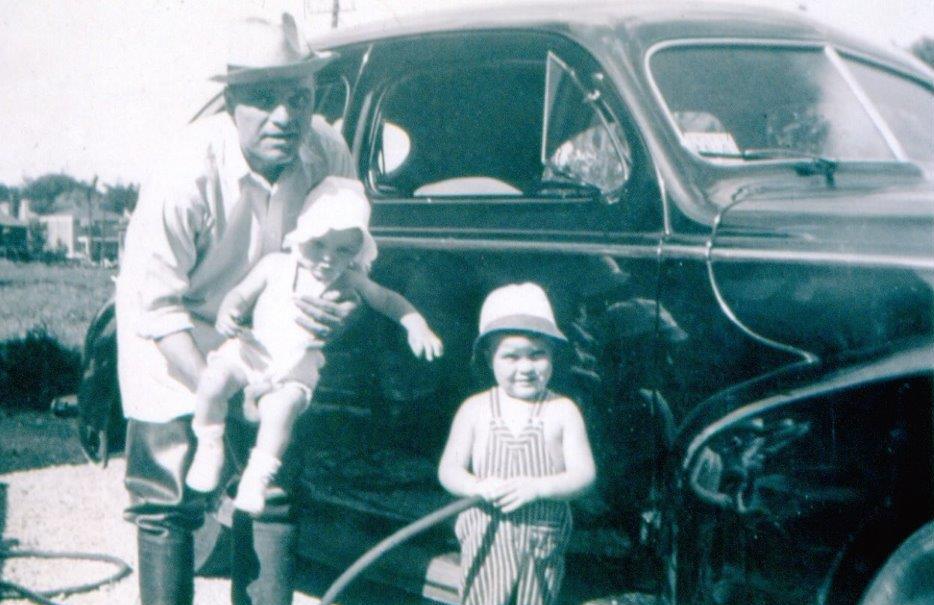
By Bill Sherk
IN 1997, I PARKED MY 1947 MERCURY 114 CONVERTIBLE in front of the used car lot office in Leamington where I washed cars for the summer of 1957 at age 15. The lot was empty and the office was closed.
Across the street was Kurt Gossen’s Mercury dealership. His favourite
song was “Gonna Buy Me a Mercury and Cruise Up and Down this Road” by the Steve Miller Band. Kurt and I arranged for the used car lot office to be donated as a historic building to Heritage Village, about 15 miles west of town.
My ’47 Mercury 114 convertible was a Ford with Mercury grille and trim built only in Canada to give MercuryLincoln dealers a car to sell in the low price field.
I was born May 4, 1942 at the Toronto General Hospital and Dad picked up Mom and me in our 1940 Mercury twodoor sedan bought new for $1,275 from Riverdale Garage, a Ford dealership.
With our car being black, the white dealer sticker just under the trunk handle could be seen from half a block away!
The photo taken by Mom in 1944 shows Dad holding me up at age two and brother John age four holding the hose. With wartime metal shortages, the sticker on the windshield was equivalent to a license plate for that year.
We became a two-car family when Dad bought a new 1948 Mercury 114 two-door sedan from Riverdale Garage. This car cost $1,800, almost 50% over the 1940 price.
The ’40 Mercury stayed in our family another two years until Dad traded it in for a new 1950 Ford. It was green, the first car in our family that was not black.
The ’48 Mercury stayed in our family until 1954, when Dad bought two new 1954 Fords, one for Mom and one for him after we moved to Leamington.
A teenager bought our ’48 Merc and drove it hard. His family had a ’48 Chev pickup with front end damage. By now, the ’48 Merc engine was toast so the front fenders of our ’48 Merc were grafted onto the Chev pickup truck renamed Merkolet (rhymes with Chevrolet).
In the summer of 1959, I was 17 and a man in town was selling his 1940 Mercury convertible. Perfect car for a teenager! He wanted $600, then took out the engine and I got it for $150! I had to push it home. Mom and Dad thought I was crazy but let me keep it because it reminded them of the ’40 Mercury that brought me home from the hospital after I was born.
I finally got it on the road at the end of the summer with a Chev V8, then sold it three years later in Toronto, where I was going to university.
In 1997, I began thinking of having an old car again. Suddenly, a 1947 Mercury 114 convertible was for sale, almost identical to the ’48 Merc 114 my parents bought new! I bought the ’47 and drove it for the next ten very happy years.
My two Mercury convertibles were tomato red, the perfect colour for Leamington, the Tomato Capital of Canada.
PHOTO #1: Dad, John, and me with our 1940 Mercury.
PHOTO #2: Dad, John, and me with our 1948 Mercury.
PHOTO #3:
Me at 17 with my 1940 Mercury convertible.
PHOTO #4:
Me at 55 with my 1947 Mercury convertible. ■
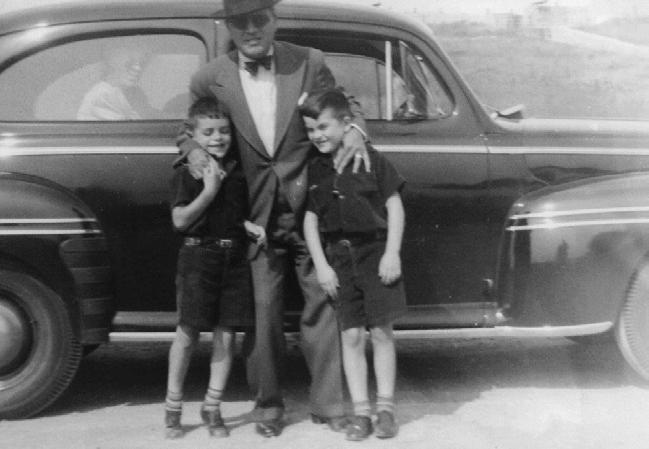

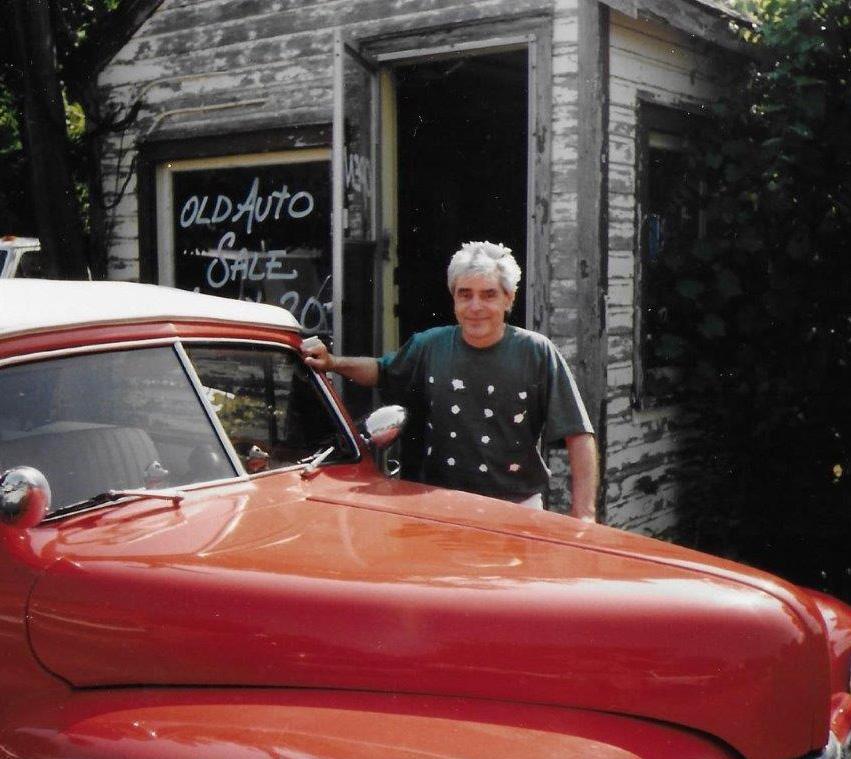
By Phoebe Wolfe

WILL YOU ONE DAY HAVE A ROBOT WITH A DIGITAL SMILEY FACE greeting your customers? Revert back to paperbased systems because at least paper doesn’t break? (We’ll ignore shredders for now.) Chances are, your plans lie somewhere in between.
You probably already use a DMS. Do you use it to track customers and leads? Shunt sales up to accounting for processing? Digital marketing efforts? What about in the future? Should you invest in more automation? Or are you considering reducing it because you find it too confusing and error-prone?
Let’s assess how to choose automation software, how implementing it may look in dealerships of different sizes, and how you can incorporate it in various departments while still maintaining a human connection between your team and your customers.
And yes, we’ll also look at some common challenges of introducing automation software to your dealership to help you navigate the transition.
Customizable Software? Scalable? Limited?
The automation software you choose and how you use it will depend on the size and goals of your operation.
Do you want software you can customize to your dealership?
That can scale as you extend its use to multiple departments?
That is easier to use and less expensive but comes with more limitations?
A dealer group with multiple locations will likely use a more extensive software solution in multiple parts of the business compared to a single dealership with fewer than 100 on staff, for instance.
During this initial research, define what specific parts of your business you plan to use automation in.
For example, if you’re only interested in automating sales tasks, you can narrow down your search criteria. Alternatively,
if you’re looking to install widespread automation in all aspects of your operations, you’ll want more versatile software.
Compile a list of all the tasks you’d like the automation solution to assist with, how soon you need it to work, and what your budget is.
Of course, no software can resolve everything for you. So, prioritize your must-haves, useful-to-haves, and nice-tohaves. Organizing your requirements and desires this way will help you maintain flexibility as you find the best fit for your organization.
Farid Ahmad, founder of Dealer Solutions Mergers and Acquisitions (DMSA), outlined three important criteria for dealers to consider when bringing on automation technology.
First, clarify that you’re going to get a worthwhile ROI (return on investment). Calculate projections on how and where
the software will bring in money and how much it might reduce your expenses. How do these numbers compare to the cost of the program?
Be realistic: a company’s marketing efforts can easily inflate these figures. Second, ensure the people who will be using the technology have the right skillset. Figure out the future users of the software and make sure they’re equipped to take it on or that you have the means to organize training for them to learn.
“For example,” Ahmad said, “if the dealer buys an automated process to desk deals, but everything is still done the oldfashioned way with pencils and sheets of paper, it's going to be very difficult to make the transition.”
Third, confirm that key decision makers and users are on board with the final decision. Avoid confusion by determining who in your organization will have the most stake in the use of automation, and confirm they’re all on the same page with the final choice.
Once you have these answers, review your options, collect quotes from several companies, and ask them directly how their software handles a dealership of your size. Many software companies will offer a free trial for a limited time before you commit to a subscription.
Quick tip #1: Take note of the use of automation in your search for an automation software. When do you receive automated communications? When does a sales rep contact you? How effective is a particular company’s use of automation and human touch?
Quick tip #2: Talk to other dealers. You may find that a solution that’s being sold to your small business may work beautifully for dealer groups, but requires hours and human resources you don’t have to implement.
Answering these additional questions will give you some perspective on how
other companies balance automation with human contact.
For some dealerships, introducing automation sounds as enticing as spending a day driving on flat tires. Businesses in existence for several decades may, for example, prefer to retain the processes they feel have helped them stay active this long. Maybe you keep almost everything on paper, have a fully in-person sales strategy, and seal it with a UCDA bill of sale.
“They [older dealerships] feel they're going to get left behind with this, and it's such a huge financial investment,” explained Ahmad. “So, technology is actually driving people out of the car business, as well.”
For dealerships of all sizes and ages, expecting the shift to a more technologyforward car buying process is important for taking on the future.
“Technology is coming, and there's going to be many changes still yet to come in the technology aspect of the automotive business,” Ahmad said.
Automation can build clear lead and customer profiles. This can range from what vehicles they’ve inquired about to whether they’ve already spoken to someone at your dealership.
A personal connection with your customers can show you understand and care about their unique tastes when picking out a vehicle. Automated solutions can better provide continuity of customer care, more detailed customer profiles to help marketing efforts, and an overview on sales compliance.
For example, you probably already have an online platform where customers can easily access information about the vehicles your dealership offers. After viewing a car (and downloading its
Carfax report if it’s a used vehicle), a customer can request to meet with a sales associate.
Scaling this basic level of automation could include tracking if this lead has been to your dealership before, what cars they viewed before requesting a meeting, and more.
Applying automation to certain sales tasks takes excess work away from your employees so they can focus on highvalue tasks, like lead conversion and customer engagement.
Of course, there’s still a balance to be met here. If customers feel that your automated sales pitches don’t apply to them because they’re too general, these leads may turn away. A phone call or personalized email directly from a sales rep may help.
On the other hand, if writing is not your salesforce’s strong point, an extra level of automation may be the answer.
When coming into the dealership, customers should know they’ll be seen and heard. Although automation is useful in the background, many dealers and car buyers still see the automotive business as a person-first business, and human interaction should lead all your decisions in automation.
“I don’t think there’s any form of technology that replaces a smile or a handshake,”Ahmad said.
So…What happens after the sale? Because most sales reps are paid on commission, many may make the mistake of not staying in touch with customers after pickup. Maybe you haven’t developed a follow-up plan because of a lack of time. Or maybe it’s out of empathy for practically everyone who receives too many emails.
But the appropriate post-sale process with a mix of automation and human touch can keep customers engaged.

For example, involving automation in customer service, diagnostics, repair and maintenance scheduling (ideally with a link to a calendar) can help your customers feel cared for.
But consider where a phone call might go a long way.
Given that salespeople are usually the first human point of contact in a dealership, have them call customers for a specific reason, e.g., “Hi, Ms. Customer. It’s Chris from the dealership. I just wanted to remind you that your vehicle is due for an oil change soon. If you’d like to schedule it with us, please let me know.”
Bringing automation into your customer service department can help your customers get the answers they need. Aside from a helpful FAQ page on your website, a properly programmed and trained automated chatbot can provide quick responses to simple queries. This AI should be able to assess if a customer needs to be transferred to a human associate to resolve the issue (i.e., by offering the customer the option of being connected to a person.)
Inventory management can include new and used cars for sale, parts and accessories, and anything else you stock to sell.
Automation can access and manage a digital copy of all your stock at any given time. This can span multiple locations, so transferring a part or vehicle from one site to another to provide ultimate convenience to your customers can become a big bonus.
A comprehensive DMS can also send your parts or sales manager automated reminders on when to reorder, and help your car sales manager monitor when they’re carrying too many of a specific vehicle.
What dealers may find the most useful, though, is that a robust inventory management system can show you if stock is missing. If inventory counts don’t match up, that can be an indication of either someone not doing their job or worse.
Using a DMS for sales, part & service, and any other departments that stock product to sell can help your dealership transition from tedious recordkeeping done by hand, decreasing operational expenses.
The best part? You can serve customers with more speed and accuracy.
Automation success isn’t automatic. You’ll likely have to work through some pain points as you introduce a new DMS to your dealership.
The main setback of automation is the initial purchasing cost of the software. The monthly subscription price for the software may not be the only cost. For example, any training in-house is time taken away from bringing in revenue, and the software company itself may charge extra for training. Potential hardware upgrades are also on the list.
For seasoned employees, being asked to suddenly take on a new system may be met with resistance.
“Without sufficient training and support, employees will rebel,” said Ahmad. That’s why getting stakeholders to buy in early in the process can help. Employees are a stakeholder group, and giving them the opportunity to see different
possibilities may ease the final transition.
Employees may come around if they have an open line of communication with you to express their concerns. This can also make training that helps them see the benefits of automation easier.
Too much dependence on automation can also lead to issues. How often have you been out shopping when the store or mall experiences a complete power loss? If the power outage lasts more than a few minutes, everyone is asked to leave.
Even if your dealership moves most of their workflow to a digital DMS, you’ll want an effective backup plan (and possible insurance) so you can keep as many processes as possible running in case of a glitch.
As mentioned earlier, keep your expectations realistic. Yes, automation may improve a lot of your operations, but it’s not a fix-all solution. Just like people have physical limits, automation has technical constraints. Remember that the software won’t always be flexible enough to fit your every desire.
To manage your expectations, implement and expand your automation gradually, starting with low-value administrative tasks so your team has time to understand its abilities.
Defining when to use automation vs. human contact will change with the years. As technology advances and expands its reach into the automotive industry, following the old expression of “going with the flow” can actually help.
With the right balance between automation and human contact, dealerships can save time and money and improve their overall standing in the communities they serve. ■
